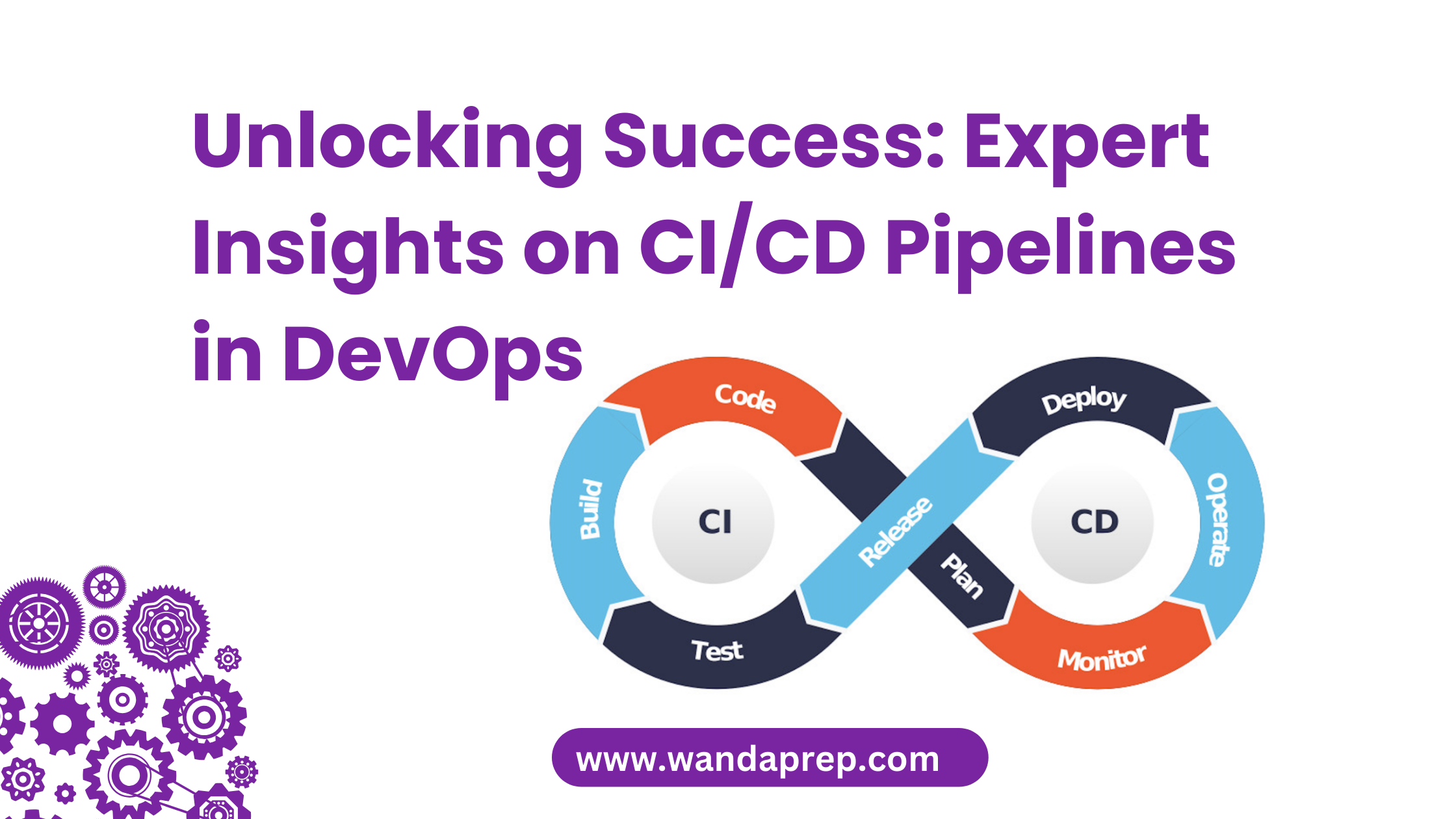
DevOps, a portmanteau of “development” and “operations,” represents a fundamental shift in the way software is developed, tested, and deployed. It emphasizes collaboration, automation, and integration between software developers and IT operations teams to deliver high-quality software at a faster pace. In modern software development, where agility, scalability, and reliability are paramount, DevOps has emerged as a crucial paradigm.
Continuous Integration and Continuous Deployment (CI/CD) pipelines are integral to DevOps practices, serving as the backbone of the software delivery process. CI/CD pipelines automate the building, testing, and deployment of code, enabling teams to deliver software changes more frequently and reliably. By streamlining the integration and deployment processes, CI/CD pipelines help organizations achieve faster time-to-market, improved software quality, and increased agility in responding to customer needs and market demands.
In this blog post, we will look into the art of mastering CI/CD pipelines, exploring their significance in the context of DevOps and providing insights into best practices, challenges, and expert interviews. Whether you’re a seasoned DevOps practitioner or just starting your journey in the field, understanding and mastering CI/CD pipelines is essential for excelling in the fast-paced world of modern software development.

Understanding CI/CD Pipelines
Definition of CI/CD Pipelines
At its core, a CI/CD pipeline is a set of practices and tools that enable teams to deliver code changes more frequently and reliably. The acronym “CI” stands for Continuous Integration, which involves automatically integrating code changes into a shared repository multiple times a day. On the other hand, “CD” encompasses Continuous Deployment and Continuous Delivery, which focus on automating the deployment and delivery of applications to various environments.
Role in Automating the Software Delivery Process
CI/CD pipelines play a pivotal role in automating the software delivery process, from code integration and testing to deployment and monitoring. By automating these tasks, teams can ensure that software changes are thoroughly tested and seamlessly deployed, leading to faster iterations and reduced manual errors. This automation not only accelerates the delivery of new features and updates but also enhances the overall quality and reliability of the software.
Key Components of a CI/CD Pipeline
A typical CI/CD pipeline consists of several key components, each essential for automating different stages of the software delivery lifecycle:
- Version Control: Utilizing a version control system, such as Git, to manage and track changes to the codebase, ensuring transparency and collaboration within the development team.
- Build Automation: Automatically compiling, building, and packaging the codebase into deployable artifacts, streamlining the process of preparing software for deployment.
- Testing: Incorporating automated testing, including unit tests, integration tests, and end-to-end tests, to validate the functionality and performance of the application.
- Deployment: Automating the deployment process to various environments, such as development, staging, and production, ensuring consistent and reliable deployment of the application.
Benefits of Mastering CI/CD Pipelines
Improved Software Quality and Reliability through Automated Testing and Deployment
By mastering CI/CD pipelines, teams can significantly enhance the quality and reliability of their software. Automated testing, an integral part of CI/CD, allows for comprehensive and consistent validation of code changes, reducing the likelihood of introducing bugs and regressions. Furthermore, automated deployment ensures that the same tested and verified artifacts are deployed across different environments, minimizing the risk of deployment-related issues and ensuring a more stable and reliable software release process.
Faster Time-to-Market and Increased Agility in Software Development
One of the most compelling advantages of CI/CD pipelines is the accelerated delivery of software. With automation driving the integration, testing, and deployment processes, teams can release new features, updates, and bug fixes at a rapid pace. This agility enables organizations to respond more effectively to evolving market demands, customer feedback, and competitive pressures, ultimately translating into a competitive edge in the industry.
Reduction in Manual Errors and Increased Efficiency in the Development Process
CI/CD pipelines are designed to streamline and automate repetitive tasks that were traditionally performed manually. As a result, the likelihood of human error is greatly reduced, leading to more consistent and reliable software releases. Moreover, the automation of build, test, and deployment processes frees up valuable time for development teams to focus on innovation, creativity, and problem-solving, thereby increasing overall efficiency and productivity.
Mastering CI/CD pipelines empowers teams to realize these benefits, fostering a culture of continuous improvement and innovation while delivering high-quality software in an efficient and timely manner.

Key Concepts and Best Practices
Overview of Essential Concepts
Mastering CI/CD pipelines involves a solid understanding of essential concepts and tools that form the foundation of efficient software delivery. These include:
- Version Control Systems: Utilizing version control systems like Git enables teams to manage and track changes to the codebase, facilitating collaboration, versioning, and code history visualization.
- Automated Testing: Automated testing, encompassing unit tests, integration tests, and end-to-end tests, is crucial for validating the functionality, performance, and reliability of the application throughout the development lifecycle.
- Deployment Strategies: Understanding various deployment strategies, such as blue-green deployments, can help in achieving zero-downtime releases and minimizing the impact of new deployments on the end user.
Best Practices for Designing Efficient and Reliable CI/CD Pipelines
In addition to understanding key concepts, implementing best practices is essential for designing efficient and reliable CI/CD pipelines. Some of these best practices include:
- Infrastructure as Code (IaC): Embracing IaC tools like Terraform or CloudFormation allows for the automated provisioning and management of infrastructure, ensuring consistency and reproducibility across different environments.
- Monitoring: Incorporating robust monitoring and alerting mechanisms into CI/CD pipelines enables proactive identification of issues, performance bottlenecks, and anomalies, thereby facilitating timely intervention and resolution.
- Feedback Loops: Establishing feedback loops throughout the CI/CD pipeline, including user feedback, automated testing feedback, and monitoring feedback, fosters continuous improvement and iterative refinement of the software delivery process.
Common Challenges and Solutions
Identification of Common Challenges in Implementing CI/CD Pipelines
Implementing CI/CD pipelines can present several challenges, which, if left unaddressed, may hinder the effectiveness and efficiency of the software delivery process. Some common challenges include:
- Complex Dependencies: Managing complex dependencies between different components of an application, especially in microservices architectures, can create challenges in ensuring consistent and reliable deployments.
- Large-Scale Deployments: Scaling CI/CD pipelines to handle large-scale deployments and diverse environments introduces complexities related to orchestration, resource management, and deployment coordination.
- Security Concerns: Integrating security measures into CI/CD pipelines to ensure the integrity and safety of the software delivery process, including vulnerability scanning, compliance checks, and secure secrets management.
Proposed Solutions and Strategies to Overcome These Challenges
To address these challenges and ensure the smooth implementation of CI/CD pipelines, teams can leverage various solutions and strategies, including:
- Modularization: Breaking down monolithic applications into smaller, more manageable modules or microservices can simplify dependency management and enhance the agility of deployments.
- Containerization: Adopting containerization technologies, such as Docker and Kubernetes, enables the encapsulation of applications and their dependencies, providing consistency across different environments and simplifying large-scale deployments.
- Security Measures: Implementing robust security measures, including automated security scanning, encryption of sensitive data, and role-based access control, helps in safeguarding the CI/CD pipeline and the software delivery process against potential threats and vulnerabilities.
Interview with DevOps Experts
We had the privilege of speaking with seasoned DevOps experts to gain insights into their experiences with CI/CD pipelines and to gather valuable tips and advice for mastering CI/CD pipelines and excelling in DevOps roles.
Expert 1: Sarah Johnson, DevOps Architect at TechCo
“CI/CD pipelines are the backbone of modern software delivery,” Sarah emphasizes. “In my experience, maintaining a relentless focus on automation, testing, and feedback loops is crucial for building robust and efficient CI/CD pipelines. It’s not just about the tools; it’s about the culture of continuous improvement and collaboration across teams.”
Tips and Advice:
- “Invest time in understanding the unique needs of your organization and tailor your CI/CD pipeline to address those specific challenges.”
- “Embrace a mindset of continuous learning and adaptation, as the DevOps landscape is constantly evolving.”
Expert 2: Michael Chen, DevOps Manager at InnovateX
“The key to mastering CI/CD pipelines lies in embracing a holistic approach,” Michael shares. “Considering factors such as infrastructure as code, security, and observability is essential for building resilient and scalable pipelines that can support the dynamic needs of modern software development.”
Tips and Advice:
- “Foster a culture of experimentation and innovation within your teams, allowing for continuous refinement and optimization of the CI/CD pipeline.”
- “Seek opportunities to collaborate with cross-functional teams, as DevOps is as much about cultural transformation as it is about technical excellence.”
Expert 3: Alex Patel, DevOps Consultant at CloudOps
“Security is a non-negotiable aspect of CI/CD pipelines,” Alex emphasizes. “Implementing security measures early in the pipeline, such as vulnerability scanning and secure secrets management, is critical for ensuring the integrity and trustworthiness of the software delivery process.”
Tips and Advice:
- “Stay updated with industry trends and best practices, and be proactive in integrating new technologies and methodologies into your CI/CD pipelines.”
- “Cultivate a deep understanding of the business objectives and customer needs, aligning your CI/CD pipeline with the broader organizational goals.”
Conclusion
In the realm of modern software delivery, CI/CD pipelines stand as a cornerstone of DevOps practices, enabling organizations to achieve agility, reliability, and efficiency in their software development and deployment processes. By automating key stages of the software delivery lifecycle, CI/CD pipelines facilitate rapid iterations, improved software quality, and seamless deployments, ultimately empowering teams to meet the demands of today’s dynamic and competitive market landscape.
As we conclude, we encourage readers to embark on a journey of exploration and mastery of CI/CD pipelines. The insights shared by DevOps experts, coupled with the foundational concepts, best practices, and proposed solutions, offer a comprehensive starting point for individuals looking to delve deeper into the art of CI/CD pipelines. Embracing this journey not only enhances technical expertise but also opens doors for career growth and advancement within the realm of DevOps.
In essence, the mastery of CI/CD pipelines is not just a technical pursuit; it is a transformative journey that empowers individuals to shape the future of software development and DevOps practices. We encourage you to embrace this journey, explore the depths of CI/CD pipelines, and embark on a path of continuous growth and excellence in the realm of DevOps.
For further guidance in DevOps and Cloud, Visit Wandaprep today!
